We gazed at the star attraction of Kaziranga National Park in Assam – the Asiatic One-horned rhino – confused. The beast posing for our cameras on our elephant safari was downright ugly. Beady eyes, a big long snout with a wart-like horn, an overhanging upper lip, long pointed ears, terrible skin, obese… Yet, we had to concede that he was an amazingly handsome hunk who commanded our attention to the exclusion of everything around him. And like a model who was aware of his striking good looks, he posed for us – looking straight into our lenses and then presenting a picture-perfect profile.
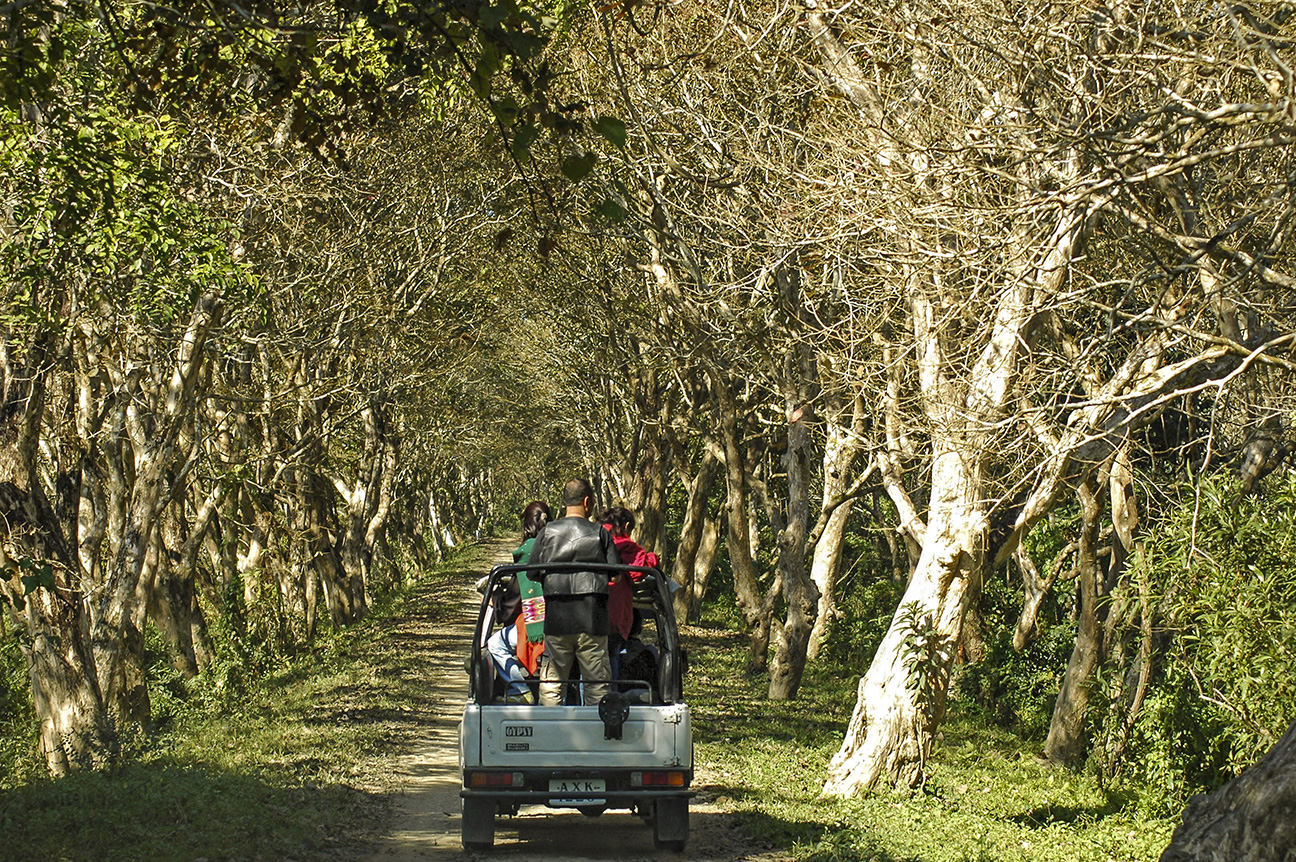
Out in these untamed wilds, a fleeting thought injected itself in our stream of consciousness and we found ourselves offering silent thanks to Lady Curzon for saving these magnificent animals from extinction. Way back in 1904, the wife of Lord Curzon, the Viceroy of India visited the area in the hope of seeing the rhino in its natural habitat. All she got to see were its pugmarks, droppings and little else. Poachers had systematically felled the great beast for its prized horn till only twelve remained. She realised that the matter called for action at the highest level and prevailed upon her husband to declare Kaziranga as a protected area.
The rest, as they say, is history. Kaziranga’s conservation effort is an amazing success story. In 1926, Kaziranga was declared a Reserve Forest, in 1940 a Wildlife Sanctuary and, soon after, a National Park. In 1985, Kaziranga National Park was declared a United Nations World Heritage Site. According to Forest Department statistics, the rhino population touched 366 in 1966, 1,700 in 1993 and stood at 2,413 in 1918.

Though Kaziranga was not part of the Project Tiger conservation programme till 1908, the big cat has thrived there thanks to the protection offered to the rhino. Currently, over 100 tigers stalk its wilds. Though we did not see a tiger during the game drive following the elephant safari, we did get to see its gruesome handiwork: the half-eaten leg of a baby elephant it had killed two days earlier. The brown stump-like remains by the side of the road was a grim reminder that there was a dark side to this seemingly idyllic Garden of Eden: that the brutal laws of nature – eat and be eaten – still prevailed.
Savage paradise
We had entered this savage paradise through the Mihimukh gate where a sweep of grassland was smudged with silvery-blue pools of water. A snow-white egret rode the back of a rhino as it strolled across nature’s grand canvas. We pulled up alongside an embankment further down the safari trail and climbed to the top of an observation tower and gazed out at the ever-changing tapestry of a flock of pelicans swimming with pendulum-like regularity in front of a wading rhino; wild ducks lazing on a finger of land that needled the water; black-necked storks balancing on red stilt-like legs in the shallows; flocks of birds gracefully soaring into the blue skies above, the feathers on the tips of their wings twitching as they navigated the wind currents…
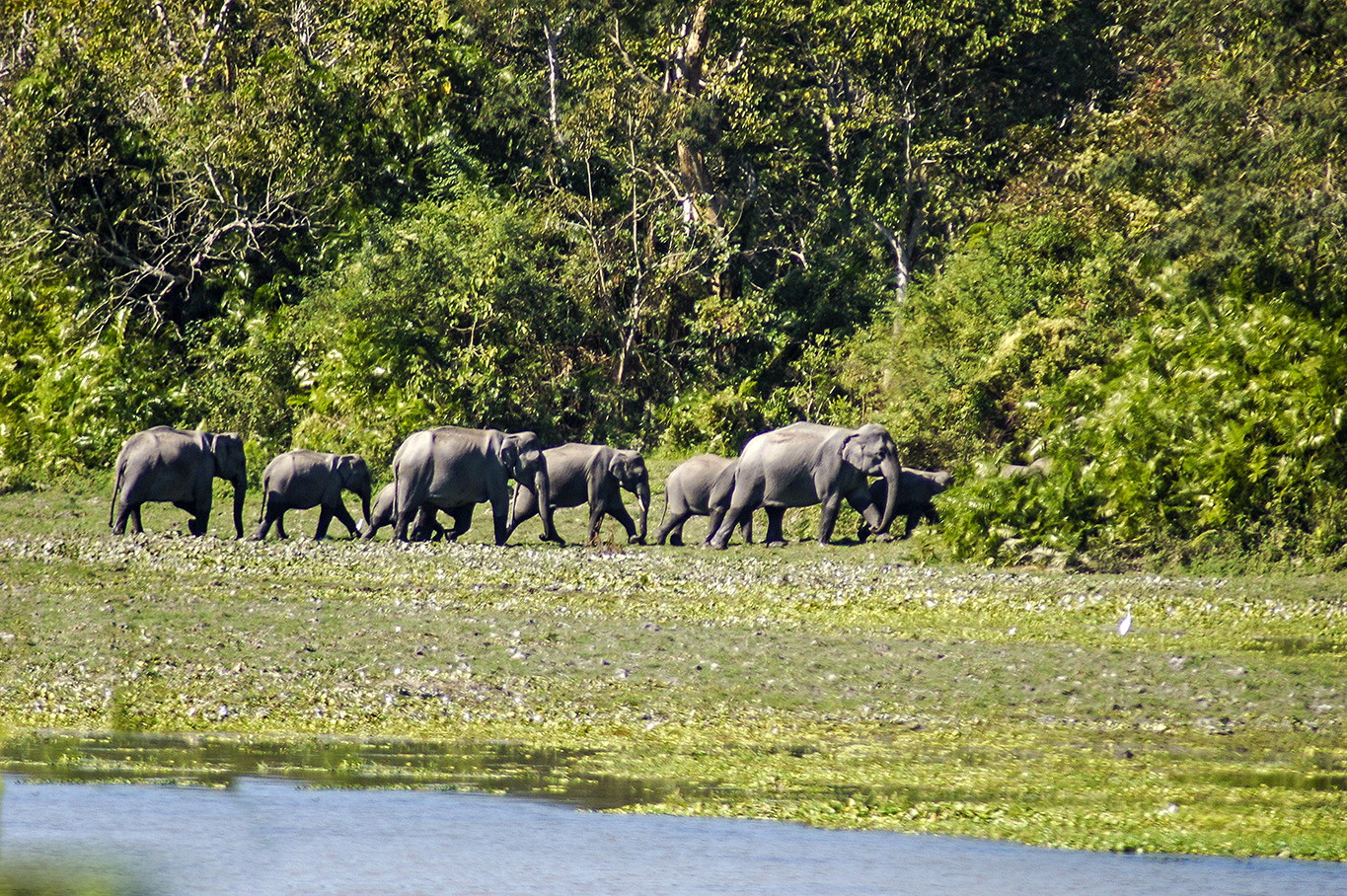
According to the forest ranger accompanying us (all vehicles are required to have one), Kaziranga is a sanctuary for over 500 species of birds. Even if the park were devoid of mammals, it would still be one of the best bird watching sites in India. But the truth is that it is home to a variety of wild residents, large and small. We were rewarded with excellent sightings of herds of wild Indian water buffalo and barasinghas, the males carrying their 12-point antlers with ballerina-like grace.
Since much of Kaziranga is open country covered by wetlands and grasslands, wildlife viewing is a treat. Around January, each year, the tall elephant grass that provides cover for animals is burned by the Forest Department in controlled stages and from February onwards up to the monsoons – when the park is closed to tourist traffic – animal sightings are the best.
However, there are sections when the safari trail ducks through dense forests that are watered by the Brahmaputra. Once the monsoons set in around mid-June, the placid water of the river is transformed into a torrential flood that spreads itself like a giant all-consuming slug across the park. These are trying times for the rhinos and other residents of the park who must retreat to the surrounding highlands or risk being stranded on the many temporary islands that emerge across the floodplains or, worse, drowning in the rising waters. Come October, when the monsoons and the floodwaters abate, the animals return to more hospitable habitat. It is also the time when the park reopens and tourists are welcomed into the animal paradise once more.
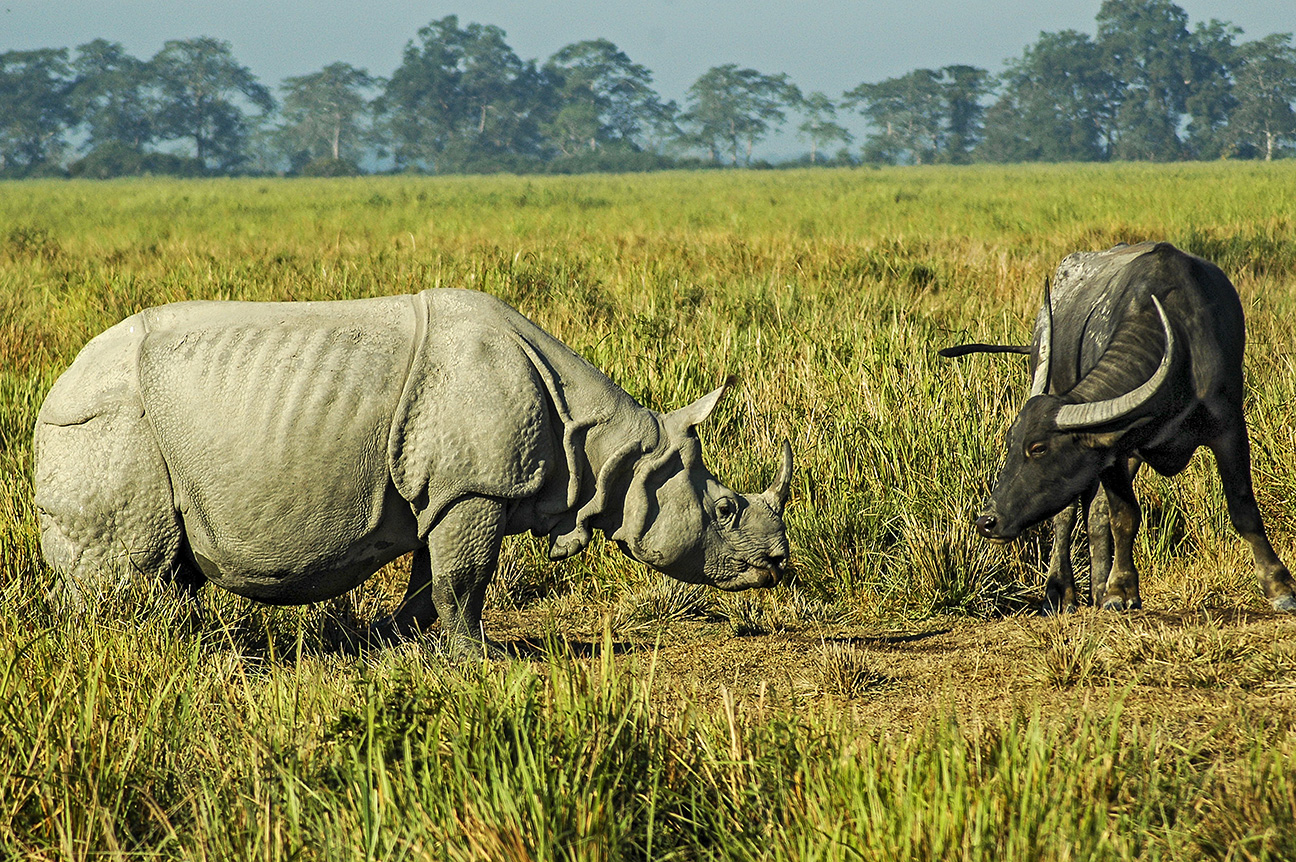
We emerged from the dense forest, and grasslands rolled out ahead of us. On a pillar at the base of an observation platform, flood levels over the years had been recorded in bright red strips. As we drove down the last leg of the safari trail, we felt a tinge of denial: Kaziranga was holding back on us and keeping one of its treasures under wraps – elephants; not the ones that take visitors on a safari but the ones that roam free in the wilds. Just as we started to reconcile ourselves to the fact that a safari is a roll of the dice when it comes to animal sightings, we came upon a herd of elephants grazing on water hyacinths a few metres from the dirt track. Upon seeing us, the matriarch started to organise the retreat of her brood; the babies lined up in single file, the youngest in the front and the older ones behind, as they marched off towards the thicket.
One greedy youngster lingered on to feed on the succulent vegetation only to earn the displeasure of the matriarch who trumpeted her discontent; a chilling, thrilling blast that reverberated across the wildlife park. The young elephant immediately responded to the warning and hurried off to join the rest of the herd as it melted into the forest.
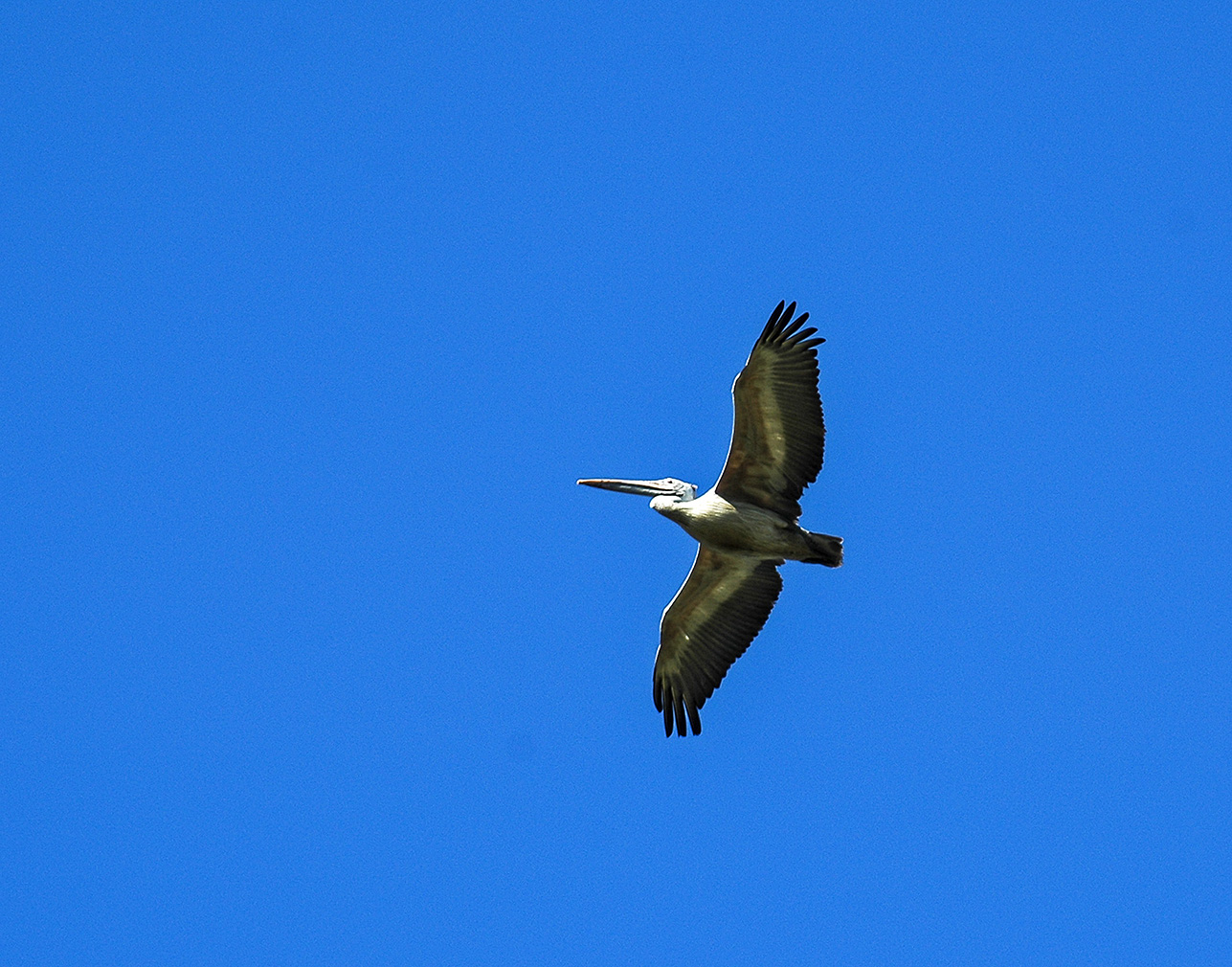
It was time for us too to leave the soothing calm of the forest and head back to the bustle of civilisation.
Fact File
Jorhat (96 km) and Guwahati (225 km) are the two closest airports to Kaziranga.
Bokakhat is the closest town to the entrance of Kaziranga National Park.
By way of accommodation, Assam Tourism runs a number of lodges, including Aranya Lodge. All the lodges, hotels and resorts – government and private – are located outside the park.
Most lodges and resorts will help arrange jeep and elephant safaris for their guests.
Elephant safaris (prior reservation is essential) operate only during the early morning. The duration of the safari is around 45 minutes.
Jeep safaris are conducted in open vehicles. Forest department guides and guards (at a price) must accompany every vehicle that enters the park.
There are three safari trails within the park: Kohora or central range (the most popular one and the venue of the Elephant safari) Agaratoli or eastern range (a birder’s paradise) and Bagori or western range.
The park is closed during the monsoon months. The best time to visit the park is between February and May when the elephant grass is burnt and game viewing is at its best.
Animal spotting at Kaziranga safari
The vast open grasslands and water bodies in Kaziranga National Park makes wildlife viewing both easy and unique and visitors are very likely to spot rhino, elephant, hog deer, sambar, barasingha, water buffalo, turtle… and abundance of birds including water birds. You may probably spot Langur monkey, Gibbon, wild boar and snakes. If you are lucky then you are likely to spot tiger, bear, otter, leopard and gangetic dolpin.

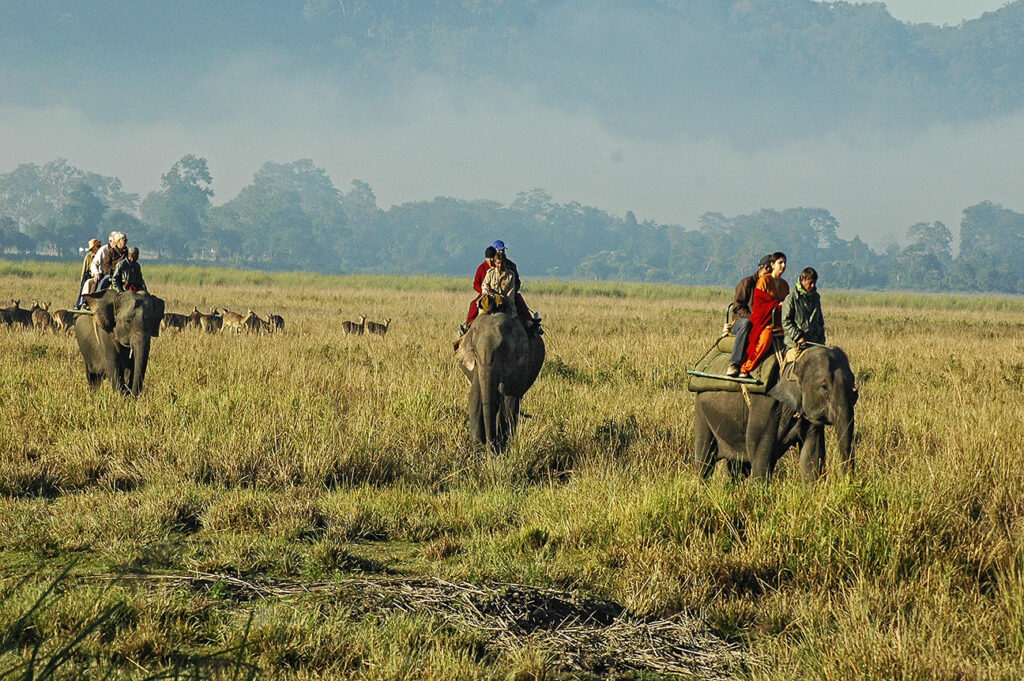
 [/column]
[/column]